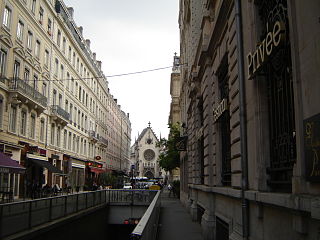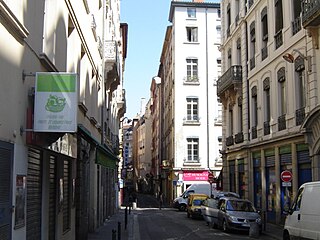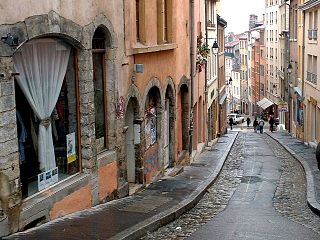Trunkmaking
French philosopher Denis Diderot and Jean d'Alembert made mention of a Malletier and his techniques in their Encyclopédie, ou Dictionnaire raisonné des sciences, des métiers et des arts (1713-1784) :
A malletier is, in French, literally a trunk-maker, or manufacturer of luggage and suitcases. .
French philosopher Denis Diderot and Jean d'Alembert made mention of a Malletier and his techniques in their Encyclopédie, ou Dictionnaire raisonné des sciences, des métiers et des arts (1713-1784) :
The first houses of malletiers appeared in Paris the middle of the 19th century. The most famous historical malletiers include:
Au Départ , founded in 1834 upon the advent of railway travel. In 1847 Au Départ opened a shop at 7 boulevard Denain in Paris, opposite the Gare du Nord. The brand was revived in 2019. [1]
Le Bazar du Voyage, established in 1843 and currently disappeared, is known to be the oldest French malletier.
Aux États-Unis , established in 1845 and disappeared in the late 1980s. The store was located at 229 rue Saint-Honoré in Paris. The house was famous for the monogrammed canvases, composed of diamonds.
La Malle Bernard, established in 1846, is one of the first malletiers to have developed a complete line of luggage and remains as the "oldest trunk maker in existence."
Moynat was established in Paris in 1849 by Pauline Moynat. The House had its own factory in Paris. The store located at the corner of the Avenue de l'Opéra remained opened for one hundred years. In December 2011, a new Moynat boutique was opened at 348 rue Saint-Honoré.
Goyard opened its boutique in 1853 at 233, rue Saint-Honoré in Paris. Edmé Goyard worked as a malletier then known as Maison Morel (founded in 1792), which his son, François bought out in 1853. At that time, the company was formally renamed Goyard. Goyard became a favorite malletier of the international high society including the Grand Duke of Russia, the Maharajah de Kapurthala, and The Duke and Duchess of Windsor. Goyard is known for their special orders.
Louis Vuitton , founded in 1854, was the first malletier to manufacture a flat-topped trunk, "gray Trianon canvas flat trunk" that was lightweight and airtight. All trunks before this had rounded tops for water to run off, and thus could not be stacked. It remains as the world's most popular luggage maker today.

Louis Vuitton Malletier, commonly known as Louis Vuitton, is a French luxury fashion house and company founded in 1854 by Louis Vuitton. The label's LV monogram appears on most of its products, ranging from luxury bags and leather goods to ready-to-wear, shoes, perfumes, watches, jewellery, accessories, sunglasses and books. Louis Vuitton is one of the world's leading international fashion houses. It sells its products through standalone boutiques, lease departments in high-end departmental stores, and through the e-commerce section of its website.

A trunk, also known as a travel trunk, is a large cuboid container designed to hold clothes and other personal belongings. They are most commonly used for extended periods away from home, such as for boarding school, or long trips abroad. Trunks are differentiated from chests by their more rugged construction due to their intended use as luggage, instead of the latter's pure storage.

The Rue du Faubourg Saint-Honoré is a street located in the 8th arrondissement of Paris, France. Relatively narrow and nondescript, especially in comparison to the nearby Avenue des Champs-Élysées, it is cited as being one of the most luxurious and fashionable streets in the world thanks to the presence of virtually every major global fashion house, the Élysée Palace, the Hôtel de Pontalba, the Embassy of Canada, the Embassy of the United Kingdom, as well as numerous art galleries.

Jeanne-Marie Lanvin was a French haute couture fashion designer. She founded the Lanvin fashion house and the beauty and perfume company Lanvin Parfums.

Louis Tullius Joachim Visconti was an Italian-born French architect and designer.

Maison Goyard, or simply Goyard, is a French trunk and leather goods maker established in 1792 as Maison Martin in Paris; the company also operated as Maison Morel, before becoming Maison Goyard in 1853. The brand is known for a certain amount of secrecy surrounding its products; little is known of the origins of the iconic interlocking Chevron pattern, seen on many Goyard bags.

The Louvre Saint-Honoré building is a historic structure in Paris, occupying an entire urban block between the rue de Rivoli, the place du Palais-Royal, the rue Saint-Honoré, and the rue de Marengo, with a total floor surface of 47,000 square meters. It was originally erected in the early 1850s by the Pereire brothers who in 1855 opened an iconic hotel, the Grand Hôtel du Louvre, and an innovative street-level department store, branded from 1863 the Grands Magasins du Louvre. While the Grand Hôtel closed in 1887, the Grands Magasins expanded and kept operating in the building until 1974. From 1978 to 2016 they were succeeded by a specialized mall of antiques shops, the Louvre des Antiquaires, while the upper floors were repurposed as rented office space. Since 2020, the building's lower levels have been undergoing conversion to become the new flagship home of the Fondation Cartier pour l'Art Contemporain.

The rue Saint-Honoré is a street in the 1st arrondissement of Paris, France.

Longchamp is a French leather goods company, founded in Paris in 1948 by Jean Cassegrain. The company pioneered luxury leather-covered pipes before expanding into small leather goods. Longchamp debuted women's handbags in 1971, becoming one of France's leading leather goods makers. Today, the company designs and manufactures leather and canvas handbags, luggage, shoes, travel items, fashion accessories, and women's ready-to-wear. The house is privately owned and managed by the Cassegrain founding family and does business in 80 countries through around 1,500 retail outlets.

Jean-François Houbigant was a French perfumer who founded the second oldest perfumery in France. He established a modest shop in 1775 at 57 rue du Faubourg-Saint-Honoré. He chose a basket of flowers to identify the front of his shop and that emblem will remain the symbol of Houbigant through the years.

The Rue de la Bourse is a street located mainly in the 2nd arrondissement of Lyon, and also in the 1st arrondissement. It starts on the Place des Cordeliers, in the 2nd arrondissement, in front of the Église Saint-Bonaventure, and ends at right angles to the Rue du Bât-d'Argent, beyond which it is extended by the Rue du Garet.

The rue Sainte-Catherine is a very old street at the foot of the slopes of La Croix-Rousse quarter, in the 1st arrondissement of Lyon. It is particularly known for being a drinking street. The street belongs to the zone classified as World Heritage Site by UNESCO.

The Montée de la Grande Côte, or the Montée de la Grande-Côte, is a street of La Croix-Rousse quarter, in the 1st arrondissement of Lyon, which connects the Terreaux quarter and the Plateau de la Croix Rousse. It is characterized by a high elevation and is more narrow at the bottom. The street belongs to the zone that is classified as World Heritage Site by UNESCO.
Moynat is a Parisian trunkmaker, founded in Paris in 1849 by Octavie and François Coulembier. They collaborated with a specialist in travel goods, named Pauline Moynat, to open the company's first store at Avenue de l'Opera. The house is notable for its innovations in making trunks lighter and waterproof, and for its participation in the various World's Fairs.

Belber is a heritage American leather goods company founded in Philadelphia in 1891.

Au Départ is a Parisian trunkmaker founded in Paris in 1834.

Henri Rapin was a French painter, illustrator and designer known for his Art Deco inspired contributions in various media including porcelain, leather goods, lighting and interior furnishings.
Martin-Eloy Lignereux also spelled Martin-Eloi (1751-1809) was a French marchand-mercier or decorative arts dealer. Active in Paris from 1781, he founded "la Maison Lignereux". Lignereux was popular among the upper echelons of society both at home and abroad in his own lifetime, furnishing many stately homes and aristocratic residences throughout Europe.

Luvanis S.A. is a private investment company headquartered in Luxembourg and specialized in the incubation and revival of long-dormant luxury brands, also coined as “sleeping beauties”.
Aux États-Unis is a Parisian trunkmaker established in 1845.